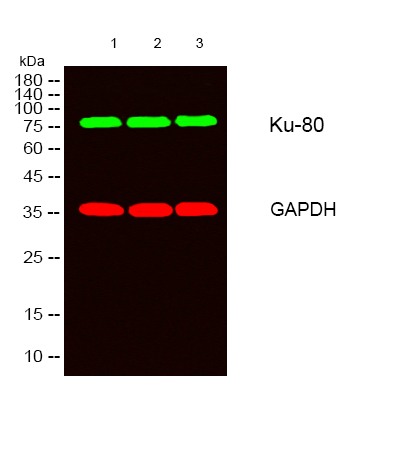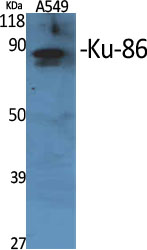STAT1 α (PT0079R) PT® Rabbit mAb
- Catalog No.:YM8042
- Applications:WB;IHC;IF;IP;ELISA
- Reactivity:Human; Mouse; Rat;
- Target:
- STAT1
- Gene Name:
- STAT1
- Protein Name:
- Signal transducer and activator of transcription 1-alpha/beta (Transcription factor ISGF-3 components p91/p84)
- Human Gene Id:
- 6772
- Human Swiss Prot No:
- P42224
- Mouse Gene Id:
- 0
- Mouse Swiss Prot No:
- P42225
- Specificity:
- endogenous
- Formulation:
- PBS, 50% glycerol, 0.05% Proclin 300, 0.05%BSA
- Source:
- Monoclonal, rabbit, IgG, Kappa
- Dilution:
- IHC 1:500-1000,WB 1:1000-5000,IF 1:200-1000,ELISA 1:5000-20000,IP 1:50-200
- Purification:
- Protein A
- Storage Stability:
- -15°C to -25°C/1 year(Do not lower than -25°C)
- Other Name:
- Signal transducer and activator of transcription 1-alpha/beta (Transcription factor ISGF-3 components p91/p84)
- Molecular Weight(Da):
- 87kD
- Observed Band(KD):
- 90kD
- Background:
- signal transducer and activator of transcription 1(STAT1) Homo sapiens The protein encoded by this gene is a member of the STAT protein family. In response to cytokines and growth factors, STAT family members are phosphorylated by the receptor associated kinases, and then form homo- or heterodimers that translocate to the cell nucleus where they act as transcription activators. This protein can be activated by various ligands including interferon-alpha, interferon-gamma, EGF, PDGF and IL6. This protein mediates the expression of a variety of genes, which is thought to be important for cell viability in response to different cell stimuli and pathogens. Two alternatively spliced transcript variants encoding distinct isoforms have been described. [provided by RefSeq, Jul 2008],
- Function:
- Signal transducer and transcription activator that mediates cellular responses to interferons (IFNs), cytokine KITLG/SCF and other cytokines and other growth factors. Following type I IFN (IFN-alpha and IFN-beta) binding to cell surface receptors, signaling via protein kinases leads to activation of Jak kinases (TYK2 and JAK1) and to tyrosine phosphorylation of STAT1 and STAT2. The phosphorylated STATs dimerize and associate with ISGF3G/IRF-9 to form a complex termed ISGF3 transcription factor, that enters the nucleus . ISGF3 binds to the IFN stimulated response element (ISRE) to activate the transcription of IFN-stimulated genes (ISG), which drive the cell in an antiviral state. In response to type II IFN (IFN-gamma), STAT1 is tyrosine- and serine-phosphorylated . It then forms a homodimer termed IFN-gamma-activated factor (GAF), migrates into the nucleus and binds to the IFN gamma act
- Subcellular Location:
- Nuclear
Suppression of the hyaluronic acid pathway induces M1 macrophages polarization via STAT1 in glioblastoma. Cell Death Discovery2022 Apr;8(1):1-13. Human U937 monocytes,U251 cell,LN229 cell anti-STAT1 antibody
Polysaccharides From the Aerial Parts of Tetrastigma Hemsleyanum Diels et Gilg Induce Bidirectional Immunity and Ameliorate LPS-Induced Acute Respiratory Distress Syndrome in Mice. Front Pharmacol. 2022 Mar;13:838873-838873. WB Mouse 1:1000 lung
CD38 affects the biological behavior and energy metabolism of nasopharyngeal carcinoma cells. INTERNATIONAL JOURNAL OF ONCOLOGY Int J Oncol. 2019 Feb;54(2):585-599 WB Human 1:1000 5-8F cell
Quantitative Proteomic Analysis Reveals That Arctigenin Alleviates Concanavalin A-Induced Hepatitis Through Suppressing Immune System and Regulating Autophagy. Frontiers in Immunology 2018 Aug 16 WB Mouse liver
Quantitative Proteomic Analysis Reveals That Arctigenin Alleviates Concanavalin A-Induced Hepatitis Through Suppressing Immune System and Regulating Autophagy. Frontiers in Immunology 2018 Aug 16 WB Mouse liver
The receptor for activated protein kinase C promotes cell growth, invasion and migration in cervical cancer. INTERNATIONAL JOURNAL OF ONCOLOGY Int J Oncol. 2017 Nov;51(5):1497-1507 WB Human 1:1000 cervical cancer tissues CaSki cell
gga-miR-27b-3p enhances type I interferon expression and suppresses infectious bursal disease virus replication via targeting cellular suppressors of cytokine signaling 3 and 6 (SOCS3 and 6). VIRUS RESEARCH Virus Res. 2020 May;281:197910 WB Chicken DF-1 cell
STAT1 suppresses the transcriptional activity of TRIM21 in gastric cancer. JOURNAL OF CANCER RESEARCH AND CLINICAL ONCOLOGY Li Yumin WB,IHC Mouse,Human 1:1000,1:200 MKN45 cell-xenograft AGS cell,MKN45 cell
- June 19-2018
- WESTERN IMMUNOBLOTTING PROTOCOL
- June 19-2018
- IMMUNOHISTOCHEMISTRY-PARAFFIN PROTOCOL
- June 19-2018
- IMMUNOFLUORESCENCE PROTOCOL
- September 08-2020
- FLOW-CYTOMEYRT-PROTOCOL
- May 20-2022
- Cell-Based ELISA│解您多样本WB检测之困扰
- July 13-2018
- CELL-BASED-ELISA-PROTOCOL-FOR-ACETYL-PROTEIN
- July 13-2018
- CELL-BASED-ELISA-PROTOCOL-FOR-PHOSPHO-PROTEIN
- July 13-2018
- Antibody-FAQs
- Products Images
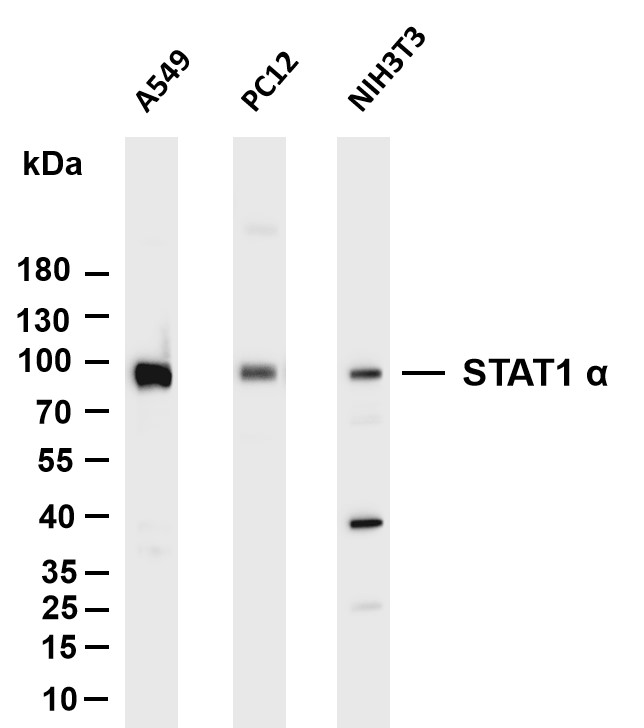
- Various whole cell lysates were separated by 4-20% SDS-PAGE, and the membrane was blotted with anti-STAT1 α (PT0079R) antibody. The HRP-conjugated Goat anti-Rabbit IgG(H + L) antibody was used to detect the antibody. Lane 1: A549 Lane 2: PC12 Lane 3: NIH3T3 Predicted band size: 87kDa Observed band size: 90kDa
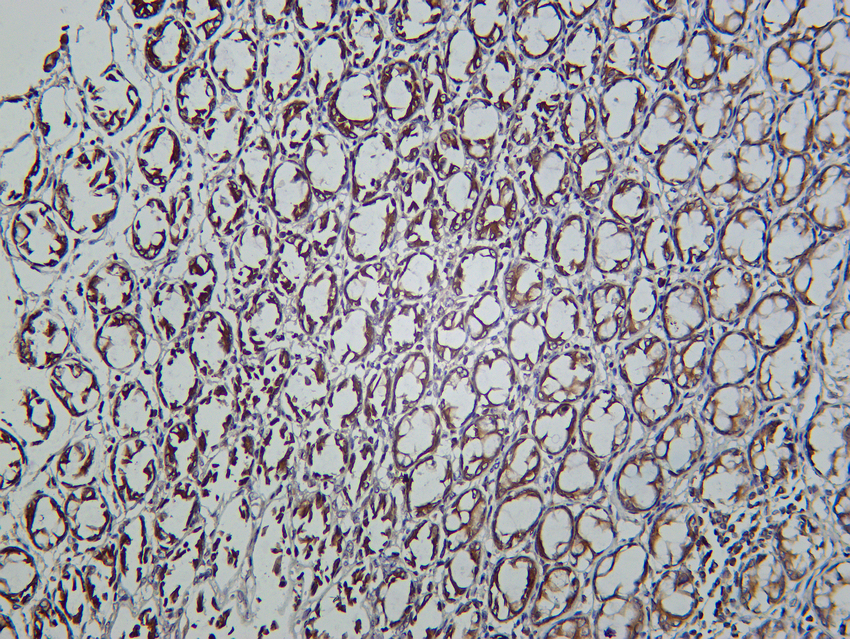
- Rat colon was stained with Anti-STAT1 α (PT0079R) rabbit antibody
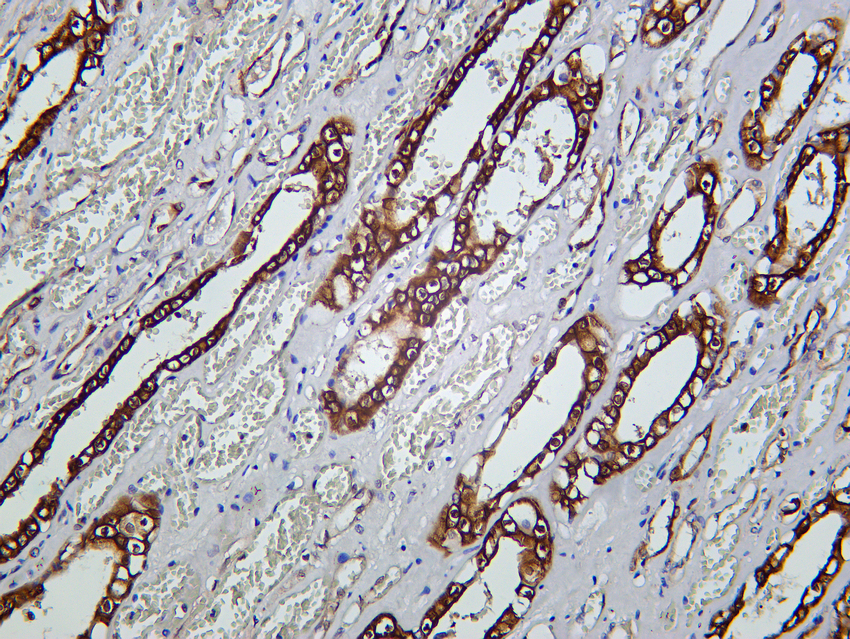
- Human kidney was stained with Anti-STAT1 α (PT0079R) rabbit antibody
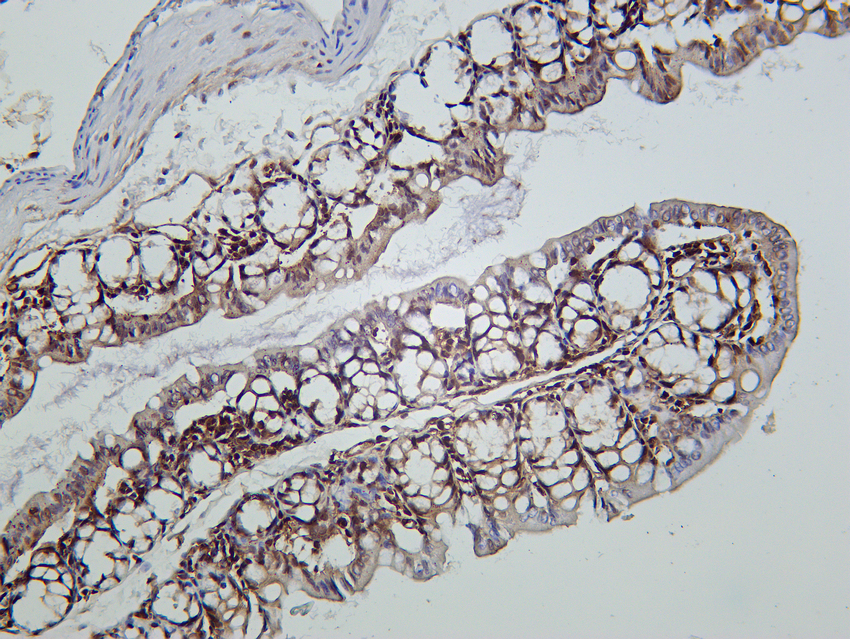
- Mouse colon was stained with Anti-STAT1 α (PT0079R) rabbit antibody
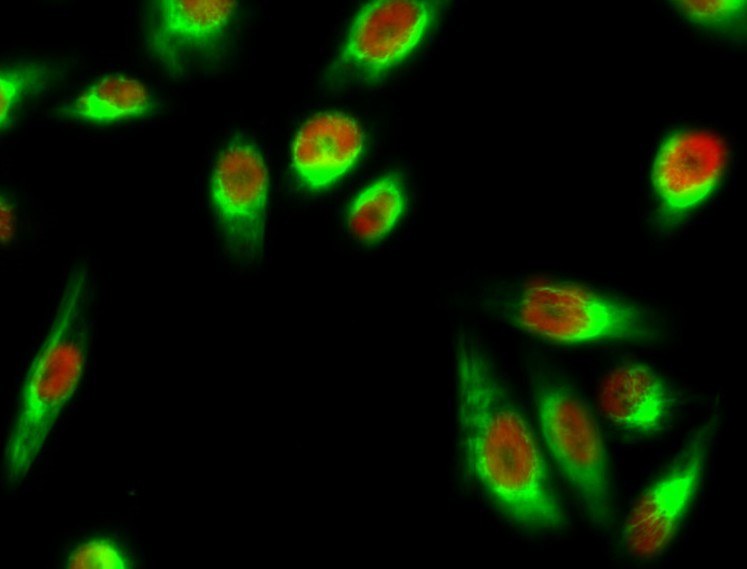
- Immunofluorescence analysis of Hela cell. 1,Stat1 Polyclonal Antibody(red) was diluted at 1:200(4° overnight). p53 Monoclonal Antibody(6C4)(green) was diluted at 1:200(4° overnight). 2, Goat Anti Rabbit Alexa Fluor 594 Catalog:RS3611 was diluted at 1:1000(room temperature, 50min). Goat Anti Mouse Alexa Fluor 488 Catalog:RS3208 was diluted at 1:1000(room temperature, 50min).
